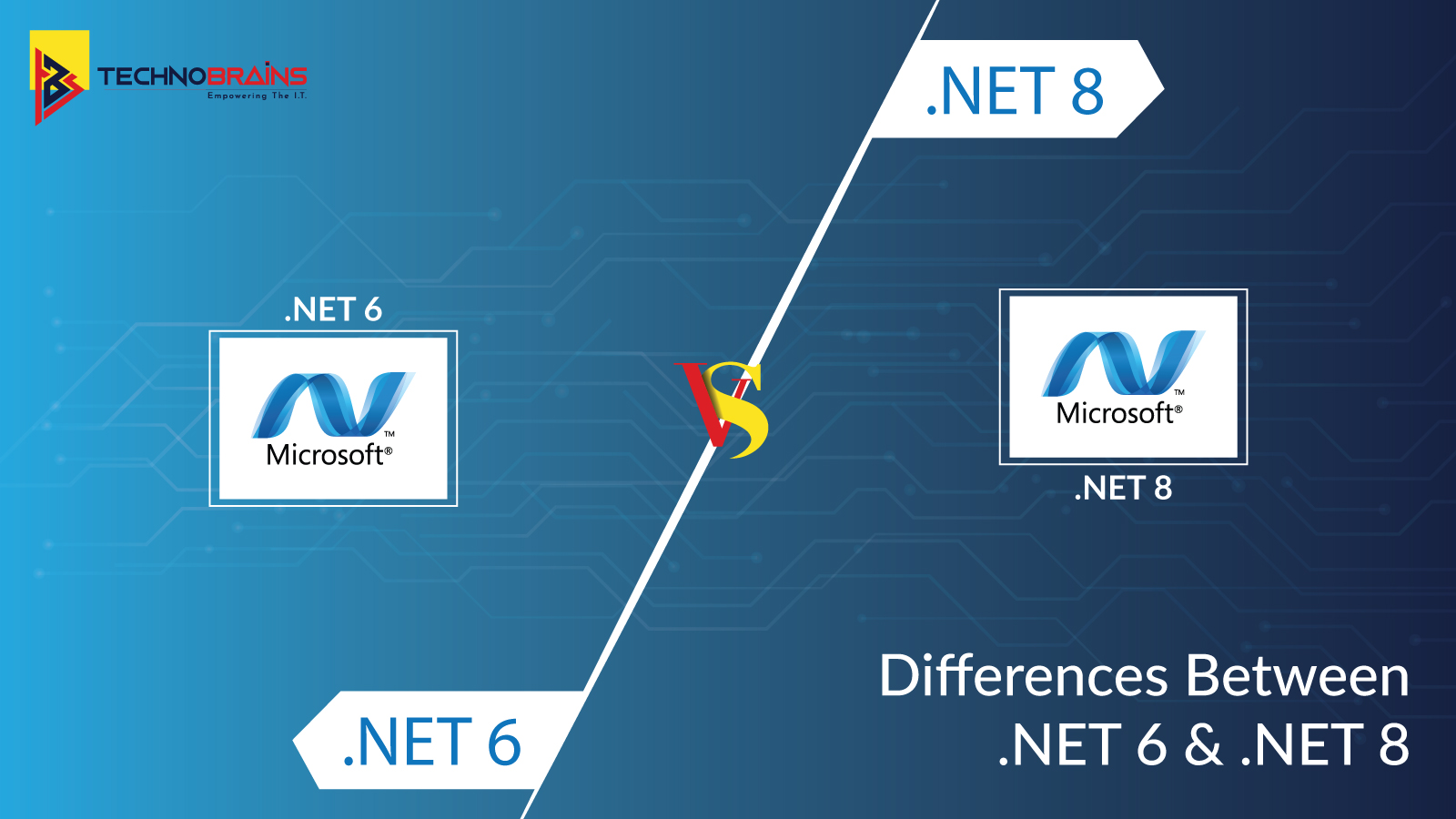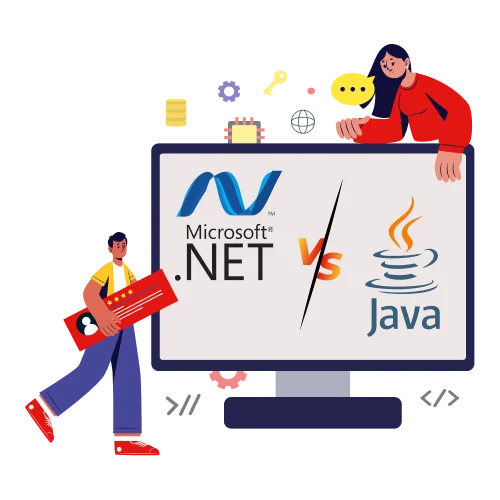Get 40 Hours Free Developer Trial
Test Our Developers for 40 Hours at No Cost - Start Your Free Trial →
A key trend in software architecture for 2020 is microservices. Microservices architecture involves loosely coupled services arranged as a single application. There are many different types of microservices, and each has its own interface. Because microservices are developed independently, applications are easier to maintain.
To support microservices, a growing number of tools and technologies have emerged. What is the best method for choosing the best method?
The 5 top technologies for microservices architecture development have been compiled below to help improve your microservices development.
What is Microservices Architecture?

Adapting to changing conditions and client needs more rapidly has become a necessity in today’s business world. Keeping up often requires fast deployment, effortless maintenance, and continuous accessibility. A lot of this can still be handled by traditional architecture, but it’s still limited. An application development approach that is more dynamic and scalable can become a critical component of the future success of the company.
A microservice architecture is an example of such an approach. As opposed to traditional monolithic architectures, microservices enable simpler and quicker software changes. These interchangeable, upgradeable, and scalable parts are then combined to create applications. In an ideal world, modular architecture would allow businesses to deploy innovative functionality in an agile manner, accelerating business growth. While this model is more complex than a monolithic one, it can also reduce complexity. There are many more tradeoffs to consider.
Microservice architectures have evolved as they progress along with the hype cycle from inflated expectations to disillusionment and onto an upward path toward enlightenment. How do microservices compare with traditional services? Find out what we run into most often here.
A microservice – or microservices architecture – is a collection of loosely coupled services that is arranged or architected as a microservice. Characterize the microservices by the following characteristics:
- Data models and data management are specific to each microservice.
- A lightweight protocol like REST or an event broker is used as a “dumb pipe” to move data between microservices.
- A small scope encompassing one business function
- External programs can only access internal operations via APIs
What Defines Microservices Architecture?
In contrast to traditional monolithic architecture, microservices architecture breaks applications into smaller components. Design the services to address a variety of business issues.
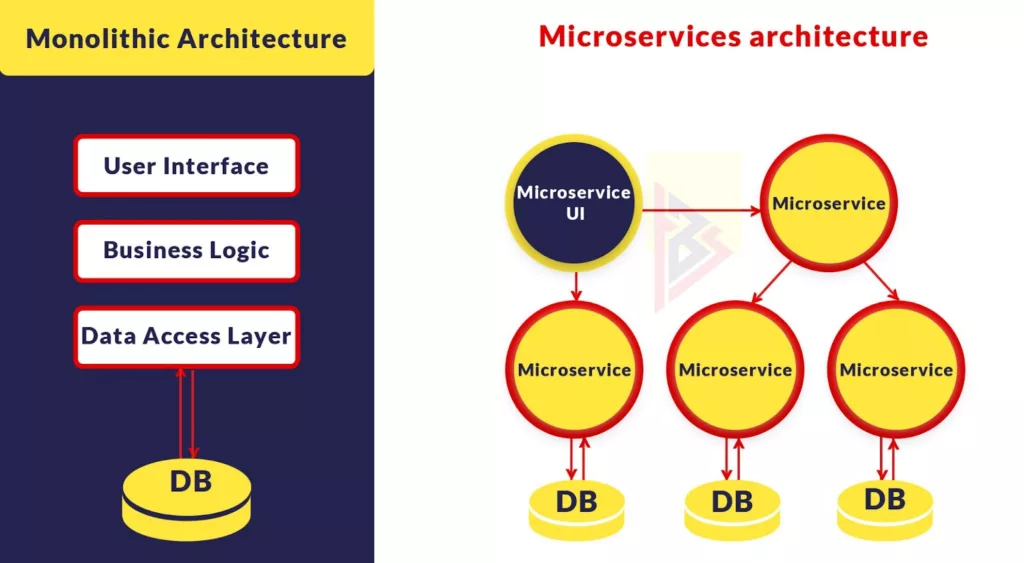
Microservices simplify deployment processes and allow developers to build cloud-ready, high-end software rapidly.
You make a single app more changeable, scaleable, and deployable by fragmenting it into smaller programs. Data is stored in various ways in the microservices architecture.
In response to microservices’ growing popularity, many new technologies and tools have come up. Let’s look at some of the most effective ways to develop microservice architecture.
Monolithic vs. Microservices Architecture
Understanding microservices requires an understanding of monolithic applications and what led to the shift to microservices in recent years.
Monolithic Architecture
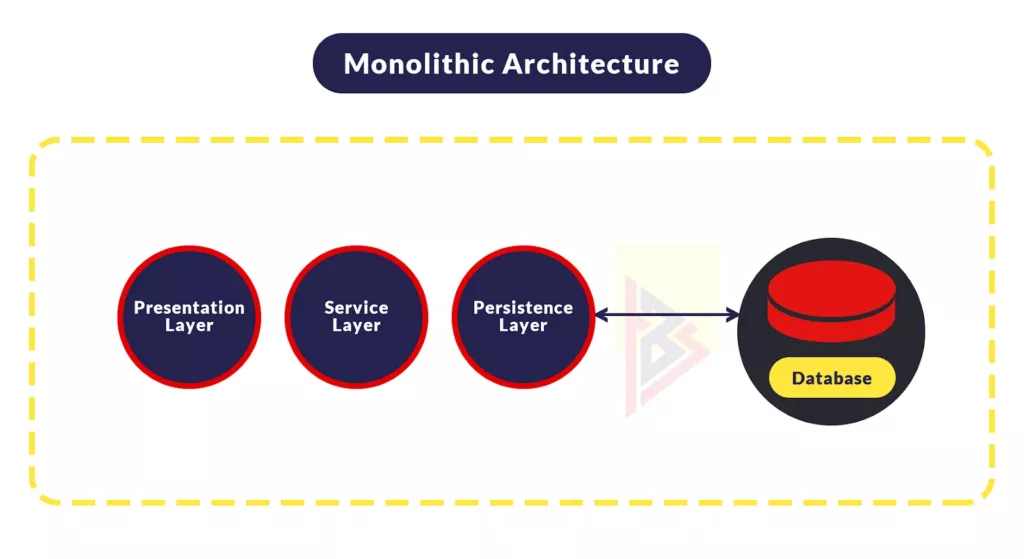
The word monolith refers to a complete composition. In monolithic applications, components are combined into a single program on a single platform as part of a single program. Therefore, the following components can be used:
- Authorization — responsible for approving a user
- Presentation — executes HTTP requests and responds to them with either HTML or JSON/XML (for web services APIs).
- Business logic — the logic of an application.
- Database layer — a collection of objects that facilitate database access.
- Application Integration — The ability to integrate with other systems (such as messaging services or REST APIs). If there is another data source, you may integrate it.
- Notification module — sends emails when notification is necessary.
Monolithic Applications
It is known as a monolithic application if all of its functionalities are contained in one codebase. All of us have designed monolithic applications where different features were required to solve a specific problem. As part of our application development, we design the presentation, service, and persistence layers, and deploy that codebase in a single jar/war file. We are dealing with a monolithic application, where “mono” refers to a single code base encompassing all required features.
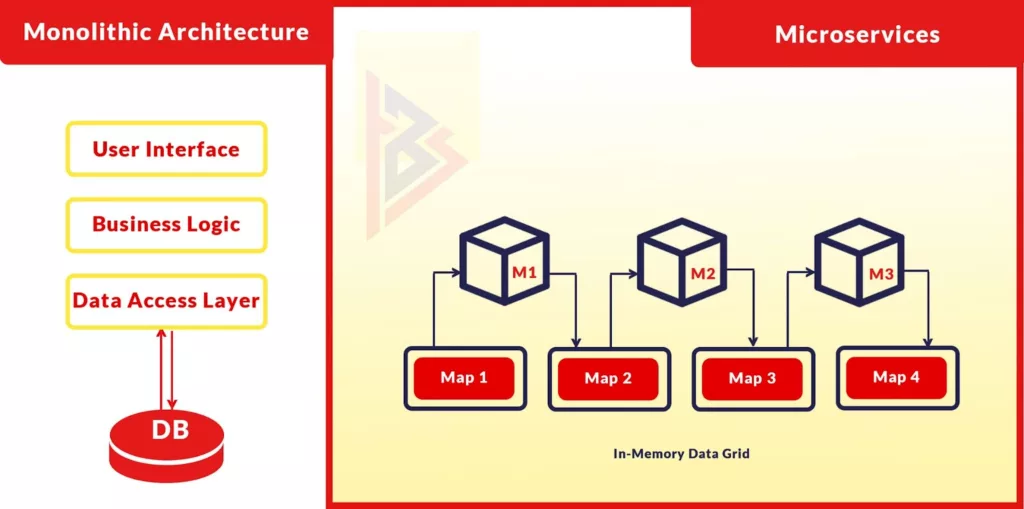
But if we already were using monolithic applications, how did microservices come about?
Disadvantages of Monolithic Applications:
- As it grows, it becomes problematic to manage and becomes too large in size.
- Every small change needs to be redeployed.
- An application’s deployment and start-up times increase as its size increases.
- Even if the developer is responsible for only one functionality in the application, it is very difficult for a new developer to understand the logic of a large monolithic application.
- The entire application should be deployed on multiple servers, even if one part of it is experiencing a heavy load. Inefficient, it eats up more resources unnecessarily. Monolithic applications cannot be horizontally scaled.
- New technologies are difficult to adopt since they affect both the timeframe and cost of the entire application.
- There is a high risk of a single bug breaking the whole monolithic application because one bug can bring the whole thing down.
Advantages of Monolithic Applications:
- The process of identifying and developing microservices requires skilled developers.
- It is easier to deploy due to the fact that only one jar/war file is deployed.
- Simpler and easier to develop than microservices architecture.
- As compared to microservices architecture, latency, and security issues are relatively less of a concern.
Reasons to Migrate to Microservices Architecture
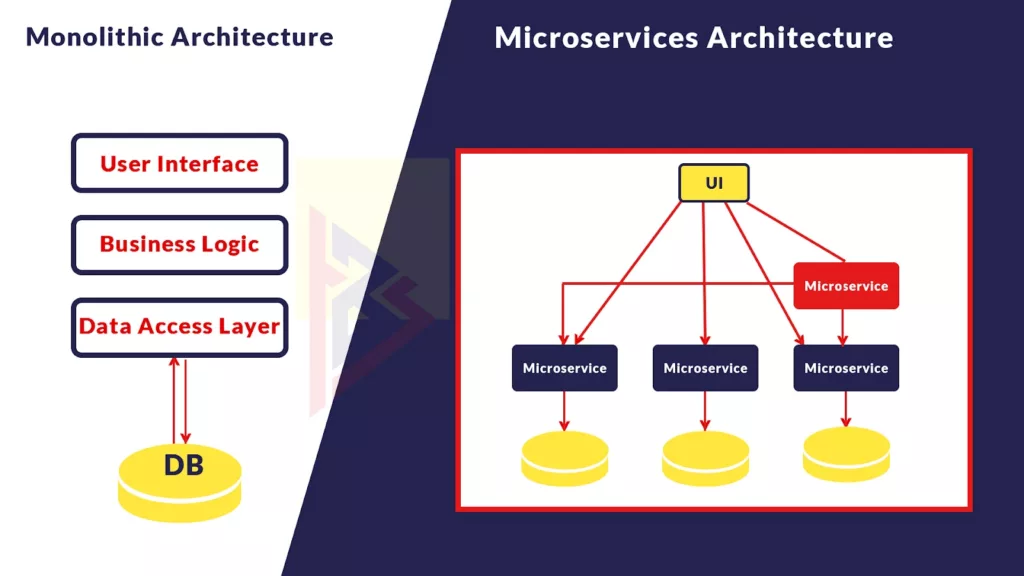
- It is difficult to comprehend the complexity and handle the code in a monolithic architecture for large applications.
- Understand the impact of software modifications through extensive manual testing.
- During the change of application, repeat the entire deployment process.
- A monolithic application is slow to start because of its heavy load.
Benefits of Microservices
- Easier Process Adoption – Microservice architecture facilitates the adoption of new technology and processes.
- Small Modules – Because of the smaller chunks of code, developers are able to develop and maintain the application more easily.
- Independent Scaling – As each module scales independently in a microservice
- Scaling on the X-axis – by cloning with more memory or CPU
- Using sharding for Z-axis scaling
- DURS – Microservices can be deployed, updated, replaced, and scalable independently (Deployed, Updated, Replaced, Scaled)
- Unaffected – If one module fails, the rest does not change.
This increased autonomy (speed to market), improved fault isolation (reliability), and reusability and scalability of development teams are all benefits of microservices.
What to Consider Before Adopting Microservices Architecture
Amazon, Netflix, Spotify, and Uber are all building products on the basis of microservices architecture. Microservices have the following advantages over traditional monolithic applications:
- Modular: By breaking down applications into smaller components, they are easier to understand, test, and develop.
- Scalable: Scanning and scaling microservices can be done independently due to their implementation and deployment.
- Robustness:
- Memory leaks affect microservices. Microservices running elsewhere continue to work.
- Security: Because microservices are isolated, attacks on one microservice will not impact the entire system.
The Development of Microservices is Dependent on the Programming Language and Infrastructure Used –
APIs or communication gateways, service discovery, the service itself, and a database or cache typically make up a microservice architecture.
The implementation, migration, and maintenance of microservices architectures present challenges, too. Microservices architecture is known to pose a number of challenges, including:
- In general, running a deployment monolith takes more effort because many more deployable units exist.
- A microservice can prevent the deployment of other microservices if it blocks the testing stage.
- Multiple microservice changes are more complex to implement than changes related to multiple modules in a monolithic deployment.
Using Technologies to Simplify the Development of Microservice Architectures
There are various tools, versions, and frameworks suitable for executing microservices. Take a look at technologies for microservice development!
1. Docker and Kubernetes
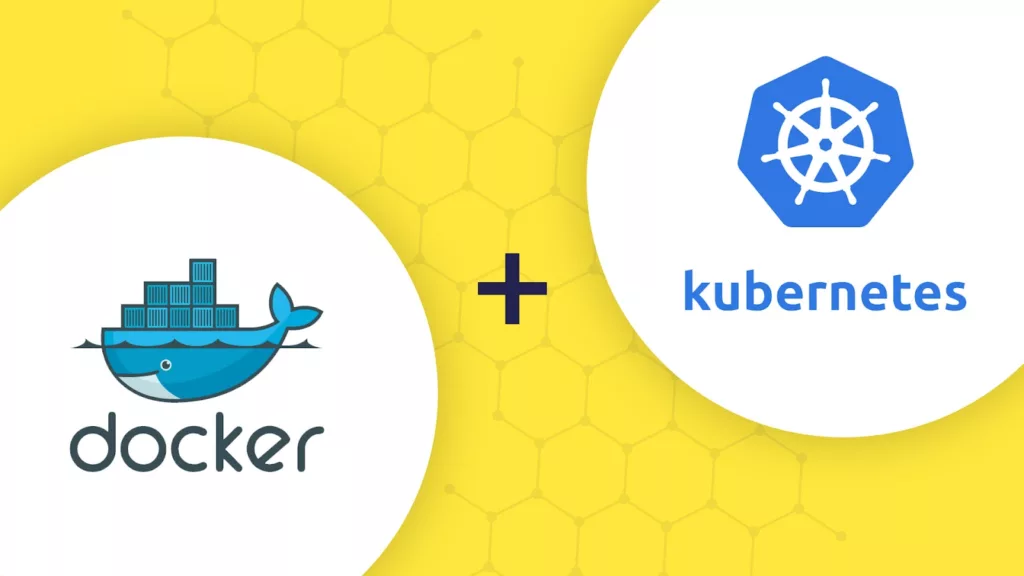
Containerization uses Docker to create self-contained packages and run software in them. As a result, containerized applications are deployed and handled manually by Kubernetes, which automates that process. Therefore, it is easier to schedule and scale containers with this tool.
One can easily create a responsive microservices architecture by combining these technologies.
Benefits of Docker
- You can deploy software easily with Docker as you only need to use Dockerfiles to deploy Docker images.
- It supports many operating systems, several tools and services that help to improve functionality, and its ability to integrate with a variety of tools and services.
- Docker is the ideal tool for continuous distribution and integration in the context of DevOps.
- To create microservices infrastructure, it’s a lightweight technology.
2. REST
A microservice communicates with another microservice through the use of REST (Representational State Transfer).
Microservices can communicate directly through HTTP using this architectural design pattern. It provides standard responses and requests in formats such as JSON, HTML, and XML.
Benefits of REST
- Create scalable microservices with this amazing tool.
- Allows for the application of the server and the client independently without the other entity being notified.
- It is possible to change codes on all sides without affecting the other side.
3. Prometheus
Designed for multiple complex application topologies containing many nodes, Prometheus is a monitoring system and alarming tool. In this tool, use key-value labels to execute multidimensional data, as well as to provide data storage and scraping. FilterData based on labels using Prometheus, an easy and rapid tool.
With Prometheus, you can see statistics and alerts in a grand visual way. It is possible to visualize data and select tracking options based on time to find anomalies easily. With its simplified dashboard interface and various graphing instruments, it is an excellent monitoring tool.
Benefits of Prometheus
- Collects and queries data in multi-dimensional ways.
- A time service can have multiple key-value dimensions and add them to the existing extensible data model.
- Build minimalist apps with simple capabilities and design.
- Microservices software systems are perfect for simple applications.
- Suitable for deployment in cloud-native environments.
4. Redis
Its versatility makes Redis an ideal technology for many applications because it provides a variety of features. A high-speed, flawless NoSQL database is designed to fix complicated coding issues by using easy commands and facilitating elasticity in data structures. As well as a core data model, Redis is able to manage streams, hashes, and more.
Platforms like Redis are highly performant.
Manage thousands of operations instantly. Also, read the operations in a millisecond. Among its other benefits, it offers distributed caching. It focuses on data persistence, seamless data distribution among microservices, and secure temporary data storage.
Benefits of Redis
- This data store provides users with many servers, apps, and processes.
- By using data management, all aspects of the data layer can be optimized, including synchronization across geographies and inter-service communication.
- Caching the app reduces the workload of the user and speeds up the app’s performance.
- Use it to handle different types of data.
5. Consul
Microservices can communicate with each other thanks to Consul technology. Service discovery has unique features that make it stand out from other technologies. As a result, you can use Consul with other technologies too since Consul Templates and DNS interfaces support.
Setting up a synchronous system with the Consul is helpful. In fact, its infrastructure meets all the basic requirements for synchronous microservices.
Benefits of Consul
- A good service discovery technology.
- Provides assistance with microservice configuration.
- The API is RESTful using HTTP.
- Perform Health checks.
- No code dependency and completely transparent.
6. RabbitMQ
By using this protocol, consistent protocols can be applied for both pub/sub messaging and queueing. Message brokers such as RabbitMQ are considered unique by most developers. Using RabbitMQ, which adds another layer of security, you can use SSL.
RabbitMQ’s multifaceted performance is superior to other message brokers. Almost half a million messages can be sent within a second using the clustering feature.
Benefits of RabbitMQ
- The microservice-based app interface is complicated, and this simplifies routing communication.
- You can use this for long-term jobs that require authentic background tasks.
- Publishers confirm and ensure features with reliability for functionality.
Building Microservices Using an API Gateway
Usually, using an API Gateway is a better approach. API Gateways serve as the single entry point into a system. The facade is an object-oriented design pattern similar to this. It provides an API that is tailored to the needs of each client and encapsulates the internal architecture of the system. In addition to handling authentication, monitoring, load balancing, caching, request shaping, and static response management, it might also perform other duties.
You can see a typical API Gateway below:
In addition to routing and composition, API Gateways translate protocols. API Gateway handles all client requests. Once the microservice is determined, requests are routed to it. API Gateways often aggregate the results of multiple microservices to manage a request. HTTP and WebSocket are web-friendly protocols and web unfriendly protocols are used internally.
Clients can also request a customized API through the API Gateway. Let’s consider the scenario for product details, for example. With the API Gateway, clients can access the product details (/product details?productid=xxx) in one request with one URL. Using the API Gateway, handle the request by combining products, reviews, recommendations, etc.
API Gateways like the Netflix API Gateway are great examples. As a result, there are hundreds of Netflix users around the world and their devices include TVs, set-top boxes, smartphones, gaming systems, tablets, etc. The initial aim of Netflix’s streaming service was to provide one-size-fits APIs. The devices and their unique requirements meant, however, that it did not work well for the diverse range of devices. By running device-specific adapter code, they provide an API tailored for each device through an API Gateway. Typically, an adapter invokes 6 to 7 backend services for every request.
Top 6 Benefits of Microservices Architecture
Take a closer look at microservice architecture and its benefits.
Isolation
Microservices are profitable because of their isolation and resilience. In case an application component fails, developers are able to use another service to keep the application running. Using this method, engineers can add and deploy components without having to change the entire app.
Scalability
Microservices are made of simple components, making it easier for developers to scale up or down based on a specific element’s requirements. Isolate the applications from massive changes when they are running correctly. Businesses working with different platforms and devices can benefit greatly from microservices.
Productivity
Microservice architecture can be easily understood in contrast to monolithic application which is not that easy to understand. Microservices are a better pick if you plan to grow your development team.
Flexibility
Microservices allow developers to select the right tools for the right job. Using a different language or framework for each server will not affect communication between microservices.
Faster project development
Changing features doesn’t require changing the codebase since microservices operate separately. Therefore, you will be able to deliver the app more quickly.
Evolutionary
Developers cannot predict what kind of devices their apps will run on, so microservices are the best choice. It is possible for developers to provide controlled upgrades without slowing down or stopping the apps.
In spite of the pros of microservices, they come with cons. For example, teams use different languages, frameworks, and libraries. A team that hasn’t developed this independence may become paralyzed. Microservice architecture is the best option if you are developing a large, complex app.
Implementing Microservice Architecture: What is the Process?
Want to implement the architecture that has helped Uber and Spotify succeed? You can follow these tips.
Mind the business objectives
It’s important to understand whether this technology is necessary for your company. Think about the case where your server already works. Microservice deployment requires the management of tens of thousands of services and a great deal of automation. In large enterprises with lots of workflows every day, microservices work best. However, if you have just started your startup, you should opt for the traditional route.
All members of the team need to grasp the concept of data modeling, API development, and asynchronous programming before they begin coding.
Choose the programming language
With microservices, developers are able to use a variety of programming languages and frameworks. Prepare your product’s technology stack in advance.
Consider data storing
Every application depends on the database. You should consider splitting the database into several tiny DBs when moving away from traditional architecture.
Use Agile methodology
Using Agile methodologies is the key to migrating to microservices. You might be able to break them up into several teams that work independently if you have a large team of developers.
Prepare your business and development team before integrating this technology. Developers and proper strategies are crucial to the success of the transition.
Read here, our in-depth blog on how we use Agile Methodology for the success of our clients.
Monitor your Microservices
Monolithic architecture has many hidden pitfalls that microservices can help developers avoid. To keep your microservice architecture under control, you need tools such as Retrace. Unlike other APM solutions, Retrace manages and monitors the performance of your application at the code level, integrating application metrics and error logs into the monitoring system.
Criteria for Choosing a Technology for Microservices
When you use microservices to extend a business, you can take advantage of the diversity of languages while building a reliable platform. Using a different technology or language for a different service does not necessarily make it effective. Due to the operation overhead of microservice architecture, adding a wide range of programming languages to that can greatly increase performance overhead.
By standardizing your microservices technology stack, you can reduce this risk by selecting the programming language that best fits your business needs. Evaluation criteria for microservices development programming languages are as follows:
- A highly observable phenomenon
- Automating the process
- Customer-centric approach
- Deploying independently
- Based on business domains
- Defining decentralized components
- Continual integration support
What are the Best Languages for Microservices?
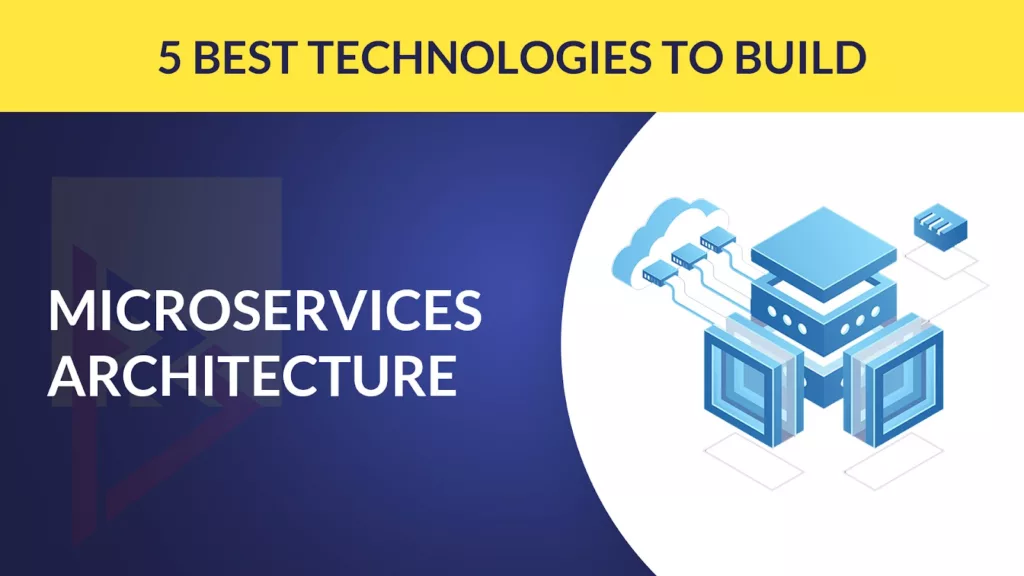
Easily implement many microservice frameworks, platforms, and tools. Python, C++, Java, Node JS, and .Net are some examples. Therefore, let us explore in more detail the languages that enable microservices development:
1. Java
Java is the perfect language for developing microservices because the annotation syntax is easy to read. When powered by Microservices frameworks, Java Microservices become much easier to develop. Increase the readability, especially when dealing with complex systems. In a single, isolated and independently deployed app, users have access to a user interface, component models, as well as back-end connections.
Furthermore, the Java EE standard suits microservices applications, including:
- APIs using Java XRS
- Data handling with JPA
- Managing lifecycles and dependency injections with CDI
Connect the Java Microservices easily to service discovery solutions, such as Consul, Netflix Eureka or Amalgam8.
In order to develop Microservices architecture, there are several frameworks available. There are several Java Microservice Frameworks available:
- The Spring Boot framework allows you to develop with a variety of languages such as inversion of control, aspect-oriented programming, and more
- Using Dropwizard, you can combine stable and mature libraries of Java into a simple, light-weight package
- RESTlet – It helps developers create RESTful web APIs
- With Spark, you can create web apps in Java 8 and Kotlin with less effort, is one of the top Java Microservices frameworks
2. Golang

Golang can be an excellent choice for microservices development if you wish to enhance an existing project. The Golang programming language and its API support in terms of microservices architecture have made it popular. Due to the concurrency of Golang, you can expect machine and CPU productivity to increase. Develop Web services using its powerful standard. Also, develop a large, complex application easily. Microservices development with Go is possible with two excellent frameworks:
- A GoMicro-based RPC framework, it comes with features such as load balancing, server packages, and PRC clients.
- Go Kit – It must be imported into a binary package for it to work like GoMirco. The ability to specify explicit dependencies, to use a domain-driven design, and to compose declarative aspects is also advanced.
Apart from its simple syntax, Go microservices also offer excellent testing support, allowing developers to integrate tests flawlessly into workflows, in addition to writing robust tests.
Read our blog on why Golang is the best language for App Development.
3. Python

With Python, you can integrate a variety of technologies into a high-level programming language. When compared to other frameworks and languages, prototyping in Python is faster and easier. For heavy implementations such as Django, it provides powerful substitutes. ASP and PHP are compatible with Microservices Python, which allows you to create a web service front end for the Microservice.
Also read, Watch Out For Python Trends 2023
Microservices Python has all these benefits, making it an advantage over other languages. Developers use a RESTful API approach to implement Microservices Python – a comprehensive technique for remotely manipulating objects utilizing web protocols & software. Therefore, it is easier to monitor the application more easily since it is now divided into components. Choosing a microservices framework for your web application development can be difficult due to the wide range of options available. The following are some examples:
- Using Jinja2 and Werkzeug, Flask is the most popular Python microframework
- Creating smart proxies, cloud APIs, and application backends with Falcon
- The Bottle micro framework is a light, fast, and simple WSGI framework
- The best Python Microservices framework that allows developers to focus on application logic Nameko
- Object-oriented, mature, Python web framework based on CherryPy
4. Node JS
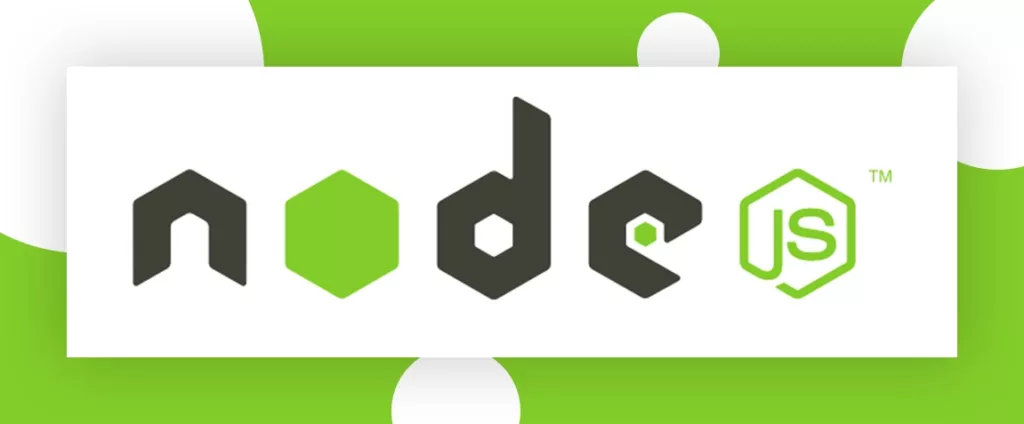
Over the past few years, companies and startups embracing microservices have gone to Node JS as their platform of choice. Consequently, microservices Node JS will be superfast for Input-Output (IO)-bound tasks because it’s built on the V8 runtime. The CPU-bound or the I/O-bound code is normally used to create Microservices Node JS applications.
Programs requiring a lot of computation demand a lot of CPU power. NodeJS never blocks the thread that is running the main thread when an IO call is made. Rather, the task is sent to the threads running the internal IO daemon. In order to streamline IO-bound tasks, Node JS Microservices gained popularity.
Often, innovative enterprises can achieve increased productivity, high performance, satisfaction for their developers, and lower costs with Microservices and Node JS together.
5. .Net
The ASP.Net framework enables easy, rapid creation of microservices based on APIs in .Net. Using Docker containers, it supports the deployment of microservices automatically. The .Net platform has APIs that enable microservices to enable services from desktop, mobile, web, gaming, and other applications. It is possible to adopt .Net microservices without having to rewrite an application in its entirety.
Microservices provide .Net developers with the ability to combine a variety of technologies between apps; this allows you to use .Net for just one part of your app rather than implement it everywhere. Use .Net microservices in combination with other programming languages, such as Java, Node JS, and C++. Develop Microservices using .Net core technology and then migrate to other services and microservices built with other technologies. All cloud platforms support .Net microservices as well.
Read our blog to find out how ASP.NET is the best for microservices development.
Microservices will lead to serverless architecture in the future; especially, the promise of realizing cost savings by paying only for the amount of computing utilized can be quite compelling. A microservice refers to any application, product or solution churned onto a more granular or modular level. Therefore, keep in mind, that starting a microservice architecture from scratch is not a good idea since it’s hard to define the boundaries of each service at the very beginning.
Choosing the right microservices technology is the best way to achieve success. It is important to consider the tools you will use to implement other components of your application when making technology decisions. In addition, it’s important to know what your team already knows.
Read our blog on .NET Framework vs .NET Core.
How to Move Forward with Microservices
Microservices and traditional monolithic architectures are only set to continue evolving at the same time. Ultimately, developers must make sure they understand how their specific use cases work and do their due diligence.
Smaller companies may find it more efficient, quicker, and cheaper to start with a monolithic application, and then migrate to microservices as soon as the product has matured enough. Microservices are ideal for large companies with millions of users since they need the scalability and availability that modular architecture can provide.
How Big Companies Are Using Microservice Architecture to Their Advantage?
Several companies, like Amazon and Netflix, have been creating microservice-based apps with microservice architecture in order to reap the many benefits it brings. Therefore, see how they utilize this architectural pattern:
Netflix
The Netflix architecture shifted from monolithic to microservices. What happened? Several hours passed before Netflix was back online after a program with a missing semicolon brought down their website in 2008. As well as Netflix, they realized they were having a hard time scaling their business. Netflix grew quickly but didn’t build data centers as fast as it could. As a result, their growth began to stagnate.
Netflix, therefore, gradually switched from monolithic to microservice architecture in 2009. Having adopted it in December 2011, Netflix has gone to a microservice architecture. As a result, Netflix has now gone from a monolithic application to hundreds of microservices as a result of this drastic step. According to Netflix, their microservice architecture was able to handle 2 billion API requests daily back in December 2015.
Amazon
At the beginning of the 2000s, Amazon was experiencing a lot of issues, which affected it. As a result, the company quickly realized that this was not a sustainable model. As a result, they moved to microservices, where each service has a single function, accessible via web service APIs.
Amazon was successful in its planning as it moved to a microservices architecture
After knowing how large companies have implemented the microservice architecture pattern with lightning speed, let’s move on to the best practices to use while implementing the pattern.
Uber
Uber started out as a monolithic organization, as did other startups. Company founders found it simpler to provide UberBLACK services only. Developers chose to use multiple languages and frameworks when the startup grew rapidly, so they decided to switch to microservices. With over 1,300 microservices, Uber is now better able to scale their apps.
Spotify
To facilitate synchronization, Spotify’s founders designed a system with independent components scalable independently. As a result, for Spotify, the main advantage of microservices is their ability to prevent catastrophic failures. There will be no impact on users even if multiple services go down at the same time.
How To Implement Microservice Architecture?
If you plan to implement microservices architecture in your next project, you should keep in mind the following considerations:
- Implement this architecture using RESTful APIs
- Create a microservices-based organization
- Before committing to this architecture, make sure it has the features you need
- Clearly outline the Microservices
- Monitoring and DevOps solutions with high-quality
- Design your microservices with Domain-Driven Design
- Each microservice should have a plan for storing data
Conclusion – Should You Go For Microservice Architecture?
As a comparison to monolithic architecture, microservice architecture design and implementation is not an easy task. However, for the development process of mobile apps, microservices are very useful and handy. Enterprises with large amounts of complexity and a desire to compete on an equal playing field must embrace microservice architecture.
Therefore, developing mobile apps with microservices can have long-term benefits for startups and small businesses. In the early days of microservices architecture, early adopters like Amazon, Twitter, and Netflix achieved success. Now, it’s your turn! Contact us and we shall surely help you!
Our team at TechnoBrains Business Solutions has helped many small- and medium-sized businesses and enterprises choose the right architecture pattern. Therefore, with our enterprise software development company, we can help you find the potential that your next architectural project requires.





